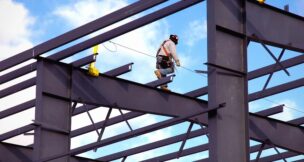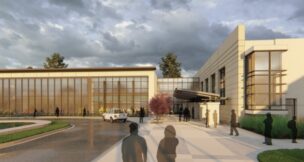DRAINING: Here’s what’s going on underneath Charleston’s streets
Jenny Peterson //September 25, 2023//
DRAINING: Here’s what’s going on underneath Charleston’s streets
Jenny Peterson //September 25, 2023//

There’s a lot going on under the streets of Charleston — about $50 million to $60 million worth of drainage projects happening at any given time.
One of the largest projects to come online in recent history is the US-17/Spring-Fishburne Project deep tunnel drainage system which is now operational and set to provide significant flooding relief to “Crosstown” or the Highway 17 interchange in downtown Charleston.
The deep tunnel project also folded in the Medical University of South Carolina and medical corridor into its system of drainage tunnels.
Phase 4 was completed earlier this year and currently functions as a "gravity system," where stormwater runs downhill into the underground tunnels which drain into the Ashley River through huge culverts built between the two bridges that cross from downtown into West Ashley, according to Matt Fountain, Director of Stormwater Management with the City of Charleston
“Areas will see greatly improved drainage, to the point where they may not flood at all in some situations where they would've previously flooded very badly,” Fountain said.
A major gamechanger in the project is a pump station. That will be construction in the final, critical step of the project and will actively draw water away from the deep underground tunnels and deposit the water into the Ashley River.
It will be another two years until construction is complete, but will actively pump water out of the area, even against the tide and hurricanes.
Fountain said the US-17/Spring-Fishburne Project has taken ten years and has a price tag of $200 million, in part funded by grants. It included redoing the surface street scape of the Crosstown, including plantings and traffic signals.
He said there is not a concern that water pumped into the Ashley River would flood waterfront properties.
“The river is seamlessly connected to the ocean and the ocean is so big that as it spreads out it, there's no way to see that increase (on land),” Fountain said.
Adding Medical University of South Carolina and the medical corridor
The Crosstown is a major throughfare that is often closed during heavy rainstorms as drivers are diverted to other roads. However, there are many neighborhoods in downtown Charleston that are prone to flooding either during rainstorms or a disastrous combination of rainstorms and high tide.
The Medical University of South Carolina and the surrounding medical corridor that includes the VA and Children’s Hospital is also prone to flooding — an area that is critical for workers and patients to access 24/7.
Fountain said the city initially did not have the medical corridor in its plans to tie into the deep tunnels, but during the course of the project, the city expanded the tunnel system, thanks to working out arrangements with MUSC executive team.
“When the project originally went forward, (we) ended up moving a section of the tunnel out of the medical district because we couldn’t get an agreement of where to put it in the medical district and also shut down roads for years,” Fountain said. “We came back with a modified design in the 2010s and MUSC offered to let us build the infrastructure on one of their properties on Ehrhardt Street and granted us easements underground for the tunnels.”
Fountain said the “Medical District Drainage Tunnel Extension at Ehrhardt Street” cost around $15 million and used a $10 million grant from the U.S. Department of Housing and Urban Development (HUD) for disaster mitigation earmarked to help hospitals.
“It was a great opportunity to leverage grant funding that was available from a disaster and say, “We can really help the hospitals in an area that has been very hard hit during these recent hurricanes.”
Deep stormwater tunnels needed to be strategically placed in order to move water out of the streets effectively. Too many drains into a tunnel can cause a backup.
“You can't keep adding (additional) neighborhoods without eventually causing problems in the really critical areas you served in the first place,” Fountain said.

Low Battery Seawall Project and check valves
A long-awaited flooding project that has been under construction since 2019 includes lifting 850-feet of seawall on The Battery by two feet due to sea level rise and add a promenade and pedestrian walkway. The final phase, Phase 3, started in April 2022 and expected to take 18 months to complete.
A new outfall for stormwater to flow into the river was added at Ashley Boulevard and the city increased the size of the Tradd Street outfall pipe from 12 inches to 36 inches.
The nearly $70 million Low Battery Seawall Project includes pedestrian improvements and park improvements along the corridor.
“The stormwater department has been trying really hard in the last four to five years to leverage our projects to make them (serve) more than one thing. The Low Battery is a good example—it doesn't look like a traditional sea wall project. We're not just pallet-driving a metal coffer dam, we're trying to also make it a beautiful linear park.”
Additional drainage improvements the city has added include adding check valves in many areas of the peninsula, which only lets water flow in one direction, so that during high tide, water can not enter pipes and drain into streets.
“Morrison Drive used to flood all the time and we put check valves in and built a berm. Now the tide has to get well over eight feet, which is a huge tide for us, before Morrison Drive will flood,” Fountain said. “The (valves) have massively reduced flooding everywhere in the peninsula, except areas around Broad Street and Lockwood, because the water comes up over the ground,” Fountain said. “The only way to block that is with a wall or a barrier.”
Market Street and beyond
The third phase of a stormwater drainage project for Market Street is now in the design phase and will consist of constructing a new, larger surface collection and system that brings water more effectively to deep tunnel collection shafts. The city is taking the opportunity to add a streetscape project on the Market from Meeting Street to East Bay Street as part of the project.
There is an existing pump station that serves “Calhoun East” around Meeting Street and the Charleston Visitor’s Center as well as a 20-year-old pump station in front of the International African American Museum on Wharfside Street that helps drainage in that area.
“We're in the middle of design and early procurement and upfitting that pump station to make it more reliable and higher-performing,” Fountain said. “We have also done some evaluations of looking at the Calhoun West, the southwest side of the peninsula, to see what would it cost to add deep tunnel systems in that area.”
The city continues to be vigilant about finding solutions for stormwater flooding.
“The first stage of any of these project evaluations is doing a computer model for the area to see what the current flooding looks like in addition to photos and information we have from residents and from our own inspections,” Fountain said. “Then we'll model it (in regards to) how will this change with sea level rise? How will it change with storm intensifications? And we will see if there is a cost-effective project that could provide an improvement to drainage in the area. We reach out to communities and talk to them about what we're seeing, our ideas for improving flooding in the area and get input from residents. Then, we come to council.”
The department also stays on top of the cost for these projects, which has included increasing the utility fee that people pay for stormwater in the city and securing additional funding.
“We certainly have been very successful in grant applications,” Fountain said.
-














